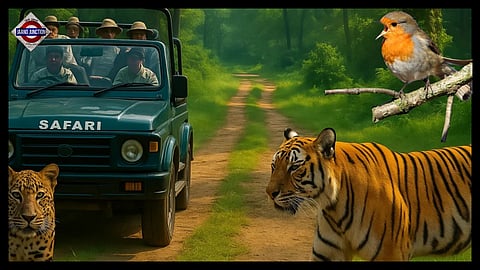

Haryana is the state better known for its vast farmlands and rapid industrial growth. It is about to get its wildest makeover yet. In a bold step, the state government is developing Asia’s largest curated jungle safari right in the ancient Aravalli hills. It will cover an area of about 10,000 acres across the Gurugram and Nuh districts. This safari park will be much larger than the popular Etawah Lion Safari in Uttar Pradesh and even bigger than the famous Sharjah Safari Park in the UAE which covers around 2,000 acres. With this mega project, Haryana hopes to create an international-level wildlife tourism spot that attracts visitors from India and abroad.
Haryana’s Wild New Face
When complete, this massive project will not only be India’s biggest safari but could also rank among the largest in the world. It is a planned area and is five times bigger than Sharjah Safari. By size alone, Haryana’s safari will be larger than many well-known open-range zoos around the globe. This means people in India will get to experience something close to an African safari without needing to fly abroad and spending thousands and lakhs. The safari is expected to feature separate large zones for lions, tigers, leopards and even cheetahs along with herbivore sections for deer, antelopes, giraffes and more. There will be bird parks, reptile houses, an underwater aquarium, butterfly gardens and botanical trails giving visitors a complete wildlife adventure.
What You’ll See Inside? Unlike traditional zoos with small cages, this safari aims to recreate natural habitats where animals have more space to roam within secure areas. Special safari vehicles will take visitors through these zones, letting people watch animals from a safe distance. The plan also includes nature trails, research centres and educational tours for students. Like this, people of all ages can learn about animal behaviour, biodiversity and conservation in an exciting way. A detailed survey is done by the Haryana Forest Department stating that this region already supports around 180 species of birds, 15 species of mammals, 29 species of reptiles and aquatic animals and more than 50 species of butterflies. The idea is to protect these native species while adding more carefully managed wildlife attractions.
Eco‑Tourism & Conservation Goals
One of the biggest promises of this safari is to boost eco-tourism and bring in green jobs for local communities. The project is part of the larger Aravalli Green Wall initiative. It aims to revive the degrading Aravalli range, stop desertification and recharge groundwater levels. Local villagers are likely to benefit as they get employment as guides, caretakers and service staff in new lodges and restaurants. International experts and experienced zoo designers will help to develop the master plan so that the safari meets global safety and sustainability standards.
The government expects this project to bring in thousands of tourists every year, boosting the local economy of Gurugram and Nuh. Officials believe it will create direct jobs for wildlife handlers, vets and guides. Indirect jobs for homestays, handicraft sellers and local transport services will also be available. Many locals, especially the youth see it as an opportunity to learn new skills and stay connected with their land instead of migrating to big cities. The state has formed the Aravalli Foundation to handle the project with funding from the Haryana government and support from the Ministry of Environment, Forest and Climate Change.
Bringing this vision to life was not easy. The decision was inspired by successful models like Sharjah Safari and Gujarat’s Vantara. After the initial concept, the Haryana Forest Department floated a global Expression of Interest to invite top designers and operators to share their ideas. Two experienced firms have now been shortlisted to work on the safari’s design and execution. The Central Zoo Authority will keep a close watch to ensure that the project follows India’s strict wildlife protection rules. While the project has received a lot of praise, it has also faced criticism. Some environmental activists have filed petitions in the Supreme Court. It states that any construction in the Aravallis must be done with utmost care because this fragile range acts as a green shield for the NCR region. There are worries that too much human interference might hurt native wildlife or make the forest more vulnerable to mining and illegal encroachments. Haryana officials, however, have assured that only barren or degraded land will be used and no native forests will be cut down. Eco-friendly practices like renewable energy and rainwater harvesting will be used to manage the safari.
Why It Matters in the World
Right now, the project is moving through surveys, planning and clearances. If all goes well, Haryana aims to open the safari’s gates in the next few years, hopefully by 2027. CM Nayab Singh Saini has promised that the government will personally monitor every stage so that the dream doesn’t get stuck in paperwork.
When it finally opens, Haryana’s Aravalli Jungle Safari could put India on the map for large-scale, sustainable wildlife experiences. Families, students, and tourists could enjoy a taste of an African-style safari within driving distance from Delhi. From roaring lions and stealthy leopards to rare birds and vibrant butterflies, the safari promises a wild adventure for everyone while reminding us how important it is to protect our forests and the creatures who call them home.
